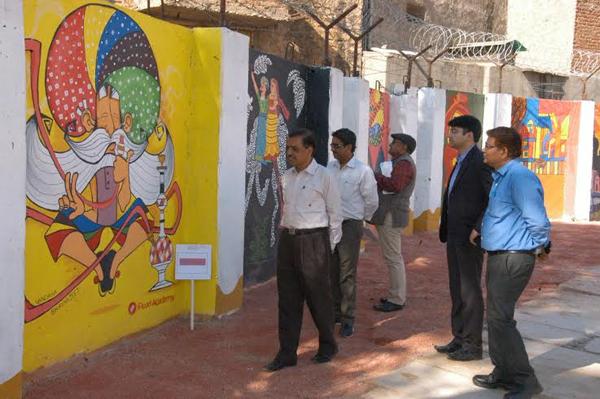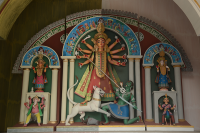 image
image
Rajasthan: High on Art
In royal Rajasthan, the walls are no longer empty spaces. They speak through their vibrant colours and tell a story. From dreary, boring railway stations to splashy coloured auto rickshaws, one can now encounter art at every nook and corner of the states bustling towns. Rajasthan Post-TWF writer R Pal reports
.jpg) High on art ! That is how the regal Rajasthan is buzzing now. A state of incredible hues, many of its cities are turning into riot of colours. Not just its famed Shekhawati region known for its intricate frescoed havelis, but the entire state is turning into an Open Air Art gallery.
High on art ! That is how the regal Rajasthan is buzzing now. A state of incredible hues, many of its cities are turning into riot of colours. Not just its famed Shekhawati region known for its intricate frescoed havelis, but the entire state is turning into an Open Air Art gallery.
So roads, bridges, railings, walls, stations, hoardings and even rickshaws and autos are all getting artsy. The newest initiative is being conducted at the state’s railway stations- both big and smaller junctions. Not just a new coat of paint and cleaner surroundings but they are fast earning the tag of public art galleries.
The tourism and culture department officials observe that Chief Minister Vasundhara Raje has an eye for all things arty. So Jogi art, a form of Rajasthan’s living folk, tribal art found their way on hoardings, bus shelters, bus panels and even auto rickshaws across the Pink City a few months back. The project, which claimed to be the first of its kind in the country, was to honour the tribal arts and artists of the desert state.
The next project was to transform the unkempt, dreary, boring railways stations into places of art, so that even common man, who has no time to appreciate the finer aspects of art, in the humdrum of his daily life, does exactly so while at the station. The idea was not only to make the surroundings pleasant but also help in providing a platform to local artists to showcase their talent and earn livelihoods.
.jpg)
So taking a cue from the Prime Minister’s ‘Swachh Bharat Abhiyan’, Raje wrote a letter to the Union Railway Minister Suresh Prabhu on 16th April 2015, requesting him that the railway stations in the state may be given a thematic facelift so that the stations stand out in terms of aesthetics, cleanliness and are also user friendly.
An idea to paint and decorate the trains to Bharatpur, Kota and Sawai Madhopur around the theme of wildlife conservation, was also put forth. The Railway Ministry promptly responded. So in partnership with WWF-India, it first painted up Sawai Madhopur station, a major station on the Mumbai-Kota-New Delhi route.
.jpg) It is also the gateway to the world renowned tiger sanctuary, Ranthambhore National Park, about 11 km away. The experiment, one of its kind in the country, was to promote idea of wildlife conservation among the people. The station is now a lively junction with colourful graffiti, bold colours, green hues and the stunning tiger trails.
It is also the gateway to the world renowned tiger sanctuary, Ranthambhore National Park, about 11 km away. The experiment, one of its kind in the country, was to promote idea of wildlife conservation among the people. The station is now a lively junction with colourful graffiti, bold colours, green hues and the stunning tiger trails.Rajasthan in partnership with Indian Railway, has now taken up painting other railway stations in the state as well. Jaipur Station is being painted up with Jogi Art, an art form that hinges around dots and lines.
Jodhpur station is being done up with Phad paintings, the essence of which are that they are completely natural. Phad paintings are huge paintings done on cloth and depict stories of local deities and gods. Scale of the figures in the painting depicts their social status of the character in the story. What is also interesting is that the figures face each other, not the audience. Phad paintings are unique because as per traditions, a thirty feet long and five feet wide work is done using natural vegetable colours. Additionally, material like squirrel hair is also used.
.jpg)
Floral motifs from Badal Mahal are being used to decorate the station in Bikaner while Udaipur is using representations from the Mewar School of Art. Mewar painting is one of the most important schools of miniature painting of the 17th and 18th centuries developed in principality of Mewar. The works of the school are characterized by simple bright colour and direct emotional appeal. An increasing number of paintings were concerned with portraiture and the life of the ruler, though religious themes continued to be popular.
The two smaller stations in Jaipur are also being done up with paintings of traditional Rajasthani Puppets and the Jaipur skyline.
.jpg) Even one of Jaipur’s new Metro stations, Mansarovar got a new 200 feet graffiti wall, replete with the city’s landmarks and all cultural icons that makes the city unique like puppets, mandna, elephants, festivals like Navratra, Gangaur, folk art and others.
Even one of Jaipur’s new Metro stations, Mansarovar got a new 200 feet graffiti wall, replete with the city’s landmarks and all cultural icons that makes the city unique like puppets, mandna, elephants, festivals like Navratra, Gangaur, folk art and others.Next in line is the Ajmer station which will see secular calligraphy, typical of the city of Dargah Sharif while Bharatpur, the haven for birds is to be done up around the theme of birds and Kota station with stylised vegetation typical of the Bundi School of Art.
Bundi painting, an important form of miniature painting lasted from the 17th to the end of the 19th century in the princely state of Bundi and its neighbouring principality of Kota. The earliest examples show Rajasthani features, particularly in the depiction of men and women, but Mughal influence is exceptionally strong. The Bundi school is characterized by a fondness for lush vegetation, dramatic night skies, a distinctive way of depicting water by light swirls against a dark background and vivid movement.
Raje, who hails from the Gwalior royal family and was married into the Dholpur royals, devotes considerable time on decking up her state with unique ideas, beginning with cleaning and beautifying Jaipur and other cities by planting flowering plants, placing huge potted plants on the main thoroughfares, widening traffic logjams, straightening, sheltering roads around religious places for devotees.
.jpg)
There is evidence that art flourished in Rajasthan as early as 2nd-1st centuries BC and continued over the centuries. In Baroli in Hadoti region, presence of several sculptures proves that a regular art school existed in the 10th century. The cave paintings, terracotta and other stone sculptures excavated at different sites corroborate this.
Each period of Rajasthan’s history witnessed its own contribution to the thriving art scene. History of Rajasthan reveals that the kings and their nobles were great patrons of arts and crafts and they encouraged their craftsmen in activities ranging from wood and marble carving to weaving, pottery and painting.
Art seems to have been an obsession with the inhabitants of this parched landscape. The desire to decorate their insipid surroundings was very strong. Nothing was overlooked. Animals from the regal elephant to the lowly donkey, the great palaces and the inner chambers of forbidding forts were decorated with as much attention as were the walls of humble mud huts.
The people also wanted to look their best when it came to adorning themselves. It was not only the women who beautified themselves, the heroic warriors extended equal attention to their clothing and armour. They went into battles with meticulously ornamented swords and shields. The horses and elephants that took the warriors to battles received the same care, jewelled saddles and intricate silver howdas were just some of the ornaments that were used to adorn them.
.jpg) For women, there was infinite variety tie and dye fabrics, embroidered garments, enamel jewellery in-layed with precious and semi-precious stones, leather jootis. They put their lives indoors to good use by decorating the walls of their mud-huts with painted geometric designs and simple ones like flowers and birds. Also women painted intricate patterns on tiles. Outdoors they used straw and twine to turn into the most beautiful items.
For women, there was infinite variety tie and dye fabrics, embroidered garments, enamel jewellery in-layed with precious and semi-precious stones, leather jootis. They put their lives indoors to good use by decorating the walls of their mud-huts with painted geometric designs and simple ones like flowers and birds. Also women painted intricate patterns on tiles. Outdoors they used straw and twine to turn into the most beautiful items.When the Rajputs came to dominate this region, it was a period of constant strife. They were almost always in battle with their neighbouring kingdoms When a kingdom fell and a new ruler took over, it was time for changing paintings depicting the new rulers victory, scenes from the battle and processions of the victorious march were faithfully reproduced on the walls and handmade paper.
Other than the paintings, the new rulers also influenced the existing crafts of that area. Despite their love for the battlefield, the Rajputs have been patrons of art, Their 350 years of contact with the Mughals led to a very strong influence on their lives and arts. Quite a few folk arts received the refinement and delicacy of the Mughal courts. They borrowed freely from the Agra and Delhi courts and in some cases, also sent their skilled craftsmen to adorn the Mughal courts.
Not just art junctions across its various cities, Rajasthan also unveiled its new tourism logo recently in January this year. With an objective to double the annual footfall of international tourists from 1.5 million to 3 million by the year 2020 and increase domestic visits from 33 million to 50 million tourists on an annual basis, the new campaign also focuses on the lesser known destinations of the state, till now relatively undiscovered and to tell its tourists that Rajasthan is no longer a one season destination but a year round travel delight. The domestic tourist inflow in Rajasthan increased by eight percent last year from the previous 2014.
So next time, tourists visit Rajasthan, don’t forget to go on the colourful, cheery, street art trails.
(www.rajasthanpost.com /Trans World Features)
Top Headlines
-
Art and Culture
Saptak Music School of Pittsburgh hosts spellbinding evening of Indian classical music
September 23, 2025
-
Art and Culture
Zigzag to clarity: Sonal Mansinghs dance of life captivates Delhi
September 08, 2025
-
Art and Culture
USA: Santoor Ashram Kolkata mesmerises Los Angeles with a celebration of Indian classical music
August 27, 2025
-
Art and Culture
'Feels like a tonic in my musical pursuits': Flute virtuoso Pandit Ronu Majumdar receives Padma Shri
June 06, 2025
-
Art and Culture
Of Paris, a chronic pain and a pivotal friendship: Frida Kahlo meets Mary Reynolds at the Art Institute of Chicago
April 16, 2025
-
Art and Culture
Prabha Khaitan Foundation celebrates 'Vasant Utsav' at Indian Museum Kolkata
March 15, 2025
-
Art and Culture
Musical concert 'Ami Bhalobashi Bangla Ke' to be held in Kolkata on April 19
February 20, 2025
-
Art and Culture
A kiss in front of The Kiss? Vienna museum's V-Day offer is ode to Klimt's artistic masterpiece
February 10, 2025
-
Art and Culture
Dalhousie Square: Timekeeping with Kolkata's British gems
January 12, 2025
-
Art and Culture
Annapurna Devi: An absent protagonist
January 11, 2025

